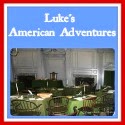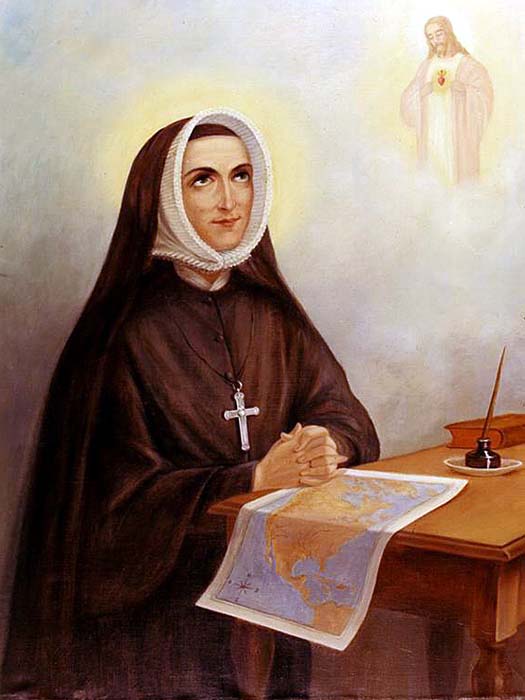There were many great revolutionaries of the late 18th and early 19th centuries, but the ones at the forefront of history are usually those who made achievements in the scientific field. Most historians overlook those who made advancements in other fields. The early 1800s saw the innovation of the American Catholic education system. St. Elizabeth Ann Seton, St. Rose Philippine Duchesne, and St. John Neumann were among those who made such advancements. Although the three all had different contributions to education, all three were leaders in the establishment of the modern Catholic education system.
Elizabeth Bayley Seton was born in New York City, New York, on August 28, 1774. Despite her high society background, Elizabeth's early years were quiet, simple, and often lonely; as she grew older, her Bible became her greatest friend. On January 25, 1794, at age 19, Elizabeth married William Magee Seton, age 25, a wealthy businessman in the import trade. Through most of their married life, William suffered from tuberculosis, and in 1803, his doctors sent the family to Italy because of the warmer climate. Because Italian immigration officials feared the family was carrying yellow fever, the family was held in quarantine for a month; shortly after their release, William died. Elizabeth and their daughter were received by the families of her late husband's Italian business partners, who introduced them to Roman Catholicism. Upon Elizabeth’s return to the United States, she converted to Catholicism. Seeing a need for education of Catholic students in the area, the president of St. Mary's College in Maryland asked Elizabeth to start a school in that city. She established a new religious order and the first Catholic school in America at Emmitsburg, MD. On March 25, 1809, Elizabeth took religious vows and became known as Mother Seton. By 1818, in addition to St. Joseph Academy and Free School for Catholic girls, the new Sisters of Charity had established two orphanages and another school. Mother Seton died in 1821 at the age of 46, also of tuberculosis. The first native-born American saint, Seton was beatified by Pope John Paul XXIII on March 17, 1963, and canonized by Pope Paul VI on September 14, 1975.
Born in Grenoble, France on August 29, 1769, Rose Philippine Duchesne was educated by Vistandine nuns. After surviving a bout of smallpox, in 1781 Rose and her cousin Josephine were sent to be educated at the nun’s Monastery of Sainte-Marie-d'en-Haut just outside of Grenoble. When she began to show a strong attraction to the monastic life, her father withdrew her from the school. In 1788, she returned to the monastery and entered the convent there, despite her family's opposition. In 1792, when French Revolutionaries shut down the monastery and dispersed the nuns, Rose returned to her family, along with two aunts who had been Visitandines at Romans-sur-Isère. She attempted to continue living in the style her Order dictated, while serving both her family and people imprisoned at her former monastery. When the Catholic Church was again able to operate openly in France under Napoleon in 1801, she attempted to re-establish the Visitandine monastery, acquiring the buildings from its new owner. Though a few of the nuns and the Mother Superior did return temporarily, the now elderly nuns found that the austere living conditions were too much for them. In 1804, the order merged with the Society of the Sacred Heart and continued to educate young women. In 1817, William Dubourg, Bishop of the American Diocese of Louisiana and the Two Floridas, visited the order’s Parisian convent. After meeting him, Rose immediately felt her old yearning for missionary service revive and begged permission from Dubourg to serve in his diocese. In 1818, Rose sailed for the United States. She established a new founded a boarding school for daughters of pioneers near St. Louis, and opened the first free school west of the Missouri. By her death in 1852, she had helped establish six communities in Missouri and Kansas, including a school for displaced Native Americans. Members of the Potawatomi tribe gave her the name of “Kwah-kah-kum-ad,” meaning the Woman Who Prays Always. Rose was beatified by Pope Pius XII in 1940 and canonized by Pope John Paul II in 1988.
John Nepomucene Neumann was born in Prachatitz, Bohemia (modern Czech Republic) on March 28, 1811. He entered the seminary to become a priest, but in 1835, the bishop of Bohemia decided there would be no more ordinations - Bohemia was overstocked with priests! John was determined to become a priest, learning English by working in a factory with English-speaking workers. He wrote to the Bishops in America, and finally the Bishop of New York agreed to ordain him. John was sent to minister to the German-speaking people who were clearing the forests around Niagara Falls. He traveled on horseback from one mission station to another, visiting the sick, teaching catechism, and training teachers to take over when he left. Despite his many responsibilities, he felt very lonely at times. Feeling the need for the fellowship of community life and for the spiritual challenge that living with other priests might bring, John entered the Redemptorist Order, and became the first Redemptorist to be professed in the United States. He served as a parish priest in Baltimore, becoming a naturalized American citizen in 1848, until he was named Bishop of Philadelphia in 1852. During his time as Bishop, immigrants were flooding the city of Philadelphia and Catholic parishes were being established almost every month. He and the Diocese helped the parishes establish an adjoining school for the education of the children of the parish. John died of a stroke on January 5, 1860 at the age of 48. Pope Paul VI beatified John Neumann on October 13, 1963, and canonized him on June 19, 1977. He is the first American bishop to be declared a saint.
Although they had differing paths to America and religious service, all three of these people were leaders in the development of the modern day Catholic education system. St. Elizabeth Ann Seton was an American married lay person who became a nun, and St. Rose Duchenne was a French religious, both in contrast to their family’s wishes. They each established convent-based schools maintained by specific religious orders. St. John Neumann’s desire for religious life was so great that he emigrated to America, where priests were desperately needed. Despite being part of the Redemptorist order, he used his position as Bishop of the Diocese of Philadelphia and saw to the establishment of a diocesan system where the school was part of a parish community. All three were Americans who shaped the foundation upon which the American Catholic School system stands upon today, and are recognized by the Canon of the Catholic Church for their contribution to education in the growing United States.

©2012- 2014 Adventures with Jude. All rights reserved. All text, photographs,
artwork, and other content may not be reproduced or transmitted in any
form without the written consent of the author.
http://adventureswithjude.com
.gif)





No comments:
Post a Comment